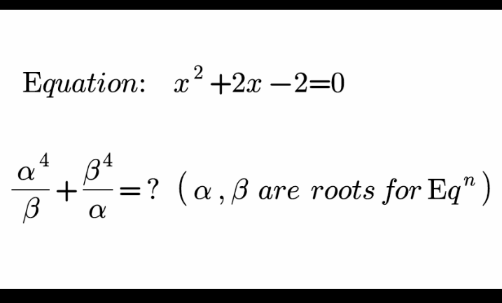Question Number 162533 by mnjuly1970 last updated on 30/Dec/21

Answered by Ar Brandon last updated on 30/Dec/21
![x^2 +2x−2=0 α+β=−2 αβ=−2 (α^4 /β)+(β^4 /α)=((α^5 +β^5 )/(αβ))=((−152)/(−2))=76 (α+β)^5 =α^5 +5α^4 β+10α^3 β^2 +10α^2 β^3 +5αβ^4 +β^5 α^5 +β^5 =(α+β)^5 −5αβ(α^3 +β^3 )−10α^2 β^2 (α+β) =(α+β)^5 −5αβ(α+β)[(α+β)^2 −3αβ]−10α^2 β^2 (α+β) =(−2)^5 −5(−2)(−2)[(−2)^2 −3(−2)]−10(−2)^2 (−2) =−32−20(10)+80=80−32−200=−152 1.1 1.2.1 1.3.3.1 1.4.6.4.1 1.5.10.10.5.1](https://www.tinkutara.com/question/Q162536.png)
$${x}^{\mathrm{2}} +\mathrm{2}{x}−\mathrm{2}=\mathrm{0} \\ $$$$\alpha+\beta=−\mathrm{2} \\ $$$$\alpha\beta=−\mathrm{2} \\ $$$$\frac{\alpha^{\mathrm{4}} }{\beta}+\frac{\beta^{\mathrm{4}} }{\alpha}=\frac{\alpha^{\mathrm{5}} +\beta^{\mathrm{5}} }{\alpha\beta}=\frac{−\mathrm{152}}{−\mathrm{2}}=\mathrm{76} \\ $$$$\left(\alpha+\beta\right)^{\mathrm{5}} =\alpha^{\mathrm{5}} +\mathrm{5}\alpha^{\mathrm{4}} \beta+\mathrm{10}\alpha^{\mathrm{3}} \beta^{\mathrm{2}} +\mathrm{10}\alpha^{\mathrm{2}} \beta^{\mathrm{3}} +\mathrm{5}\alpha\beta^{\mathrm{4}} +\beta^{\mathrm{5}} \\ $$$$\alpha^{\mathrm{5}} +\beta^{\mathrm{5}} =\left(\alpha+\beta\right)^{\mathrm{5}} −\mathrm{5}\alpha\beta\left(\alpha^{\mathrm{3}} +\beta^{\mathrm{3}} \right)−\mathrm{10}\alpha^{\mathrm{2}} \beta^{\mathrm{2}} \left(\alpha+\beta\right) \\ $$$$\:\:\:\:\:\:\:\:\:\:\:\:\:\:=\left(\alpha+\beta\right)^{\mathrm{5}} −\mathrm{5}\alpha\beta\left(\alpha+\beta\right)\left[\left(\alpha+\beta\right)^{\mathrm{2}} −\mathrm{3}\alpha\beta\right]−\mathrm{10}\alpha^{\mathrm{2}} \beta^{\mathrm{2}} \left(\alpha+\beta\right) \\ $$$$\:\:\:\:\:\:\:\:\:\:\:\:\:\:=\left(−\mathrm{2}\right)^{\mathrm{5}} −\mathrm{5}\left(−\mathrm{2}\right)\left(−\mathrm{2}\right)\left[\left(−\mathrm{2}\right)^{\mathrm{2}} −\mathrm{3}\left(−\mathrm{2}\right)\right]−\mathrm{10}\left(−\mathrm{2}\right)^{\mathrm{2}} \left(−\mathrm{2}\right) \\ $$$$\:\:\:\:\:\:\:\:\:\:\:\:\:\:=−\mathrm{32}−\mathrm{20}\left(\mathrm{10}\right)+\mathrm{80}=\mathrm{80}−\mathrm{32}−\mathrm{200}=−\mathrm{152} \\ $$$$\mathrm{1}.\mathrm{1} \\ $$$$\mathrm{1}.\mathrm{2}.\mathrm{1} \\ $$$$\mathrm{1}.\mathrm{3}.\mathrm{3}.\mathrm{1} \\ $$$$\mathrm{1}.\mathrm{4}.\mathrm{6}.\mathrm{4}.\mathrm{1} \\ $$$$\mathrm{1}.\mathrm{5}.\mathrm{10}.\mathrm{10}.\mathrm{5}.\mathrm{1} \\ $$
Commented by mnjuly1970 last updated on 30/Dec/21

$$\:\:\:\:{very}\:{nice}\:\:.{thank}\:{you}\:{so}\:{much} \\ $$$${sir}\:\:{brandon} \\ $$
Answered by Rasheed.Sindhi last updated on 30/Dec/21

$${x}^{\mathrm{2}} +\mathrm{2}{x}−\mathrm{2}=\mathrm{0};\:{a}\:\&\:{b}\:{are}\:{roots} \\ $$$${a}+{b}=−\mathrm{2}, \\ $$$${ab}=−\mathrm{2}…………………………..\mathrm{A} \\ $$$$\bullet\left({a}+{b}\right)\left({a}+{b}\right)=−\mathrm{2}\left(−\mathrm{2}\right) \\ $$$$\:\:\:\:\:\:\:\:{a}^{\mathrm{2}} +{b}^{\mathrm{2}} =\mathrm{4}−\mathrm{2}{ab}=\mathrm{4}−\mathrm{2}\left(−\mathrm{2}\right)=\mathrm{8} \\ $$$$\bullet\left({a}^{\mathrm{2}} +{b}^{\mathrm{2}} \right)\left({a}+{b}\right)=\mathrm{8}\left(−\mathrm{2}\right)=−\mathrm{16} \\ $$$$\:\:\:\:\:\:\:\:\:{a}^{\mathrm{3}} +{b}^{\mathrm{3}} +{ab}\left({a}+{b}\right)=−\mathrm{16} \\ $$$$\:\:\:\:\:\:\:\:\:{a}^{\mathrm{3}} +{b}^{\mathrm{3}} =−\mathrm{16}−\left(−\mathrm{2}\right)\left(−\mathrm{2}\right)=−\mathrm{20} \\ $$$$\bullet\left({a}^{\mathrm{3}} +{b}^{\mathrm{3}} \right)\left({a}+{b}\right)=−\mathrm{20}\left(−\mathrm{2}\right)=\mathrm{40} \\ $$$$\:\:\:\:\:\:\:\:\:{a}^{\mathrm{4}} +{b}^{\mathrm{4}} +{ab}\left({a}^{\mathrm{2}} +{b}^{\mathrm{2}} \right)=\mathrm{40} \\ $$$$\:\:\:\:\:\:\:\:\:{a}^{\mathrm{4}} +{b}^{\mathrm{4}} +\left(−\mathrm{2}\right)\left(\mathrm{8}\right)=\mathrm{40} \\ $$$$\:\:\:\:\:\:\:\:\:{a}^{\mathrm{4}} +{b}^{\mathrm{4}} =\mathrm{40}+\mathrm{16}=\mathrm{56} \\ $$$$\bullet\left({a}^{\mathrm{4}} +{b}^{\mathrm{4}} \right)\left({a}+{b}\right)=\mathrm{56}\left(−\mathrm{2}\right)=−\mathrm{112} \\ $$$$\:\:\:\:\:\:\:\:\:\:{a}^{\mathrm{5}} +{b}^{\mathrm{5}} +{ab}\left({a}^{\mathrm{3}} +{b}^{\mathrm{3}} \right)=−\mathrm{112} \\ $$$$\:\:\:\:\:\:\:\:\:\:{a}^{\mathrm{5}} +{b}^{\mathrm{5}} +\left(−\mathrm{2}\right)\left(−\mathrm{20}\right)=−\mathrm{112} \\ $$$$\:\:\:\:\:\:\:\:\:\:{a}^{\mathrm{5}} +{b}^{\mathrm{5}} =−\mathrm{112}−\mathrm{40}=−\mathrm{152}…….\mathrm{B} \\ $$$$\bullet\mathrm{A}/\mathrm{B}: \\ $$$$\frac{{a}^{\mathrm{5}} +{b}^{\mathrm{5}} }{{ab}}=\frac{{a}^{\mathrm{4}} }{{b}}+\frac{{b}^{\mathrm{4}} }{{a}}=\frac{−\mathrm{152}}{−\mathrm{2}}=\mathrm{76} \\ $$
Commented by JDamian last updated on 30/Dec/21
Mr. Rasheed: -16-(-2)(-2) = -20
Commented by Rasheed.Sindhi last updated on 30/Dec/21

$$\mathcal{TH}\alpha{n}\mathcal{X}\:\mathcal{S}{ir}!\:\mathcal{I}\:'{ve}\:{corrected}! \\ $$
Answered by Rasheed.Sindhi last updated on 30/Dec/21

$${x}^{\mathrm{2}} +\mathrm{2}{x}−\mathrm{2}=\mathrm{0} \\ $$$${a}+{b}=−\mathrm{2}\:\wedge\:{ab}=−\mathrm{2} \\ $$$${p}_{{n}} ={a}^{{n}} +{b}^{{n}} \\ $$$${p}_{\mathrm{1}} ={e}_{\mathrm{1}} =−\mathrm{2} \\ $$$${p}_{\mathrm{2}} ={e}_{\mathrm{1}} {p}_{\mathrm{1}} −\mathrm{2}{e}_{\mathrm{2}} =\left(−\mathrm{2}\right)^{\mathrm{2}} −\mathrm{2}\left(−\mathrm{2}\right)=\mathrm{8} \\ $$$${p}_{\mathrm{3}} ={e}_{\mathrm{1}} {p}_{\mathrm{2}} −{e}_{\mathrm{2}} {p}_{\mathrm{1}} \\ $$$$\:\:\:\:\:\:\:=\left(−\mathrm{2}\right)\left(\mathrm{8}\right)−\left(−\mathrm{2}\right)\left(−\mathrm{2}\right)=−\mathrm{20} \\ $$$${p}_{\mathrm{4}} ={e}_{\mathrm{1}} {p}_{\mathrm{3}} −{e}_{\mathrm{2}} {p}_{\mathrm{2}} \\ $$$$\:\:\:\:=\left(−\mathrm{2}\right)\left(−\mathrm{20}\right)−\left(−\mathrm{2}\right)\left(\mathrm{8}\right)=\mathrm{56} \\ $$$${p}_{\mathrm{5}} ={e}_{\mathrm{1}} {p}_{\mathrm{4}} −{e}_{\mathrm{2}} {p}_{\mathrm{3}} \\ $$$$\:\:\:\:\:\:=\left(−\mathrm{2}\right)\left(\mathrm{56}\right)−\left(−\mathrm{2}\right)\left(−\mathrm{20}\right)=−\mathrm{152} \\ $$$$\frac{{a}^{\mathrm{4}} }{{b}}+\frac{{b}^{\mathrm{4}} }{{a}}=\frac{{a}^{\mathrm{5}} +{b}^{\mathrm{5}} }{{ab}}=\frac{{p}_{\mathrm{5}} }{{e}_{\mathrm{2}} }=\frac{−\mathrm{152}}{−\mathrm{2}}=\mathrm{76} \\ $$$$\mathcal{N}{ote}:\mathcal{T}{he}\:{above}\:{method}\:{I}\:'{ve}\:{learnt} \\ $$$${from}\:{mr}\:{W}\:{sir}. \\ $$
Commented by Rasheed.Sindhi last updated on 30/Dec/21

$$\mathcal{S}{ir}\:{mr}\:{W},\:{pl}\:{check}\:{my}\:{above}\:{answer}. \\ $$$${Is}\:{it}\:{correct}? \\ $$
Commented by mr W last updated on 30/Dec/21
����������
Commented by mnjuly1970 last updated on 30/Dec/21

$${thx}\:{alot}\:{sir}\: \\ $$
Answered by bobhans last updated on 30/Dec/21

$$\:\mathrm{x}^{\mathrm{2}} +\mathrm{2x}−\mathrm{2}=\mathrm{0}\:\Rightarrow\begin{cases}{\alpha^{\mathrm{2}} =\mathrm{2}−\mathrm{2}\alpha}\\{\beta^{\mathrm{2}} =\mathrm{2}−\mathrm{2}\beta}\end{cases}\:\rightarrow\begin{cases}{\alpha^{\mathrm{3}} =\mathrm{2}\alpha−\mathrm{2}\alpha^{\mathrm{2}} }\\{\beta^{\mathrm{3}} =\mathrm{2}\beta−\mathrm{2}\beta^{\mathrm{2}} }\end{cases} \\ $$$$\:\begin{cases}{\alpha^{\mathrm{2}} +\beta^{\mathrm{2}} =\mathrm{4}−\mathrm{2}\left(−\mathrm{2}\right)=\mathrm{8}}\\{\alpha^{\mathrm{3}} +\beta^{\mathrm{3}} =\mathrm{2}\left(−\mathrm{2}\right)−\mathrm{2}\left(\mathrm{8}\right)=−\mathrm{20}}\end{cases} \\ $$$$\:\Leftrightarrow\:\left(\alpha^{\mathrm{2}} +\beta^{\mathrm{2}} \right)\left(\alpha^{\mathrm{3}} +\beta^{\mathrm{3}} \right)=−\mathrm{160} \\ $$$$\:\Leftrightarrow\:\alpha^{\mathrm{5}} +\alpha^{\mathrm{2}} \beta^{\mathrm{3}} +\alpha^{\mathrm{3}} \beta^{\mathrm{2}} +\beta^{\mathrm{5}} \:=−\mathrm{160} \\ $$$$\:\Leftrightarrow\alpha^{\mathrm{5}} +\beta^{\mathrm{5}} +\left(\alpha\beta\right)^{\mathrm{2}} \left(\alpha+\beta\right)=−\mathrm{160} \\ $$$$\:\Leftrightarrow\alpha^{\mathrm{5}} +\beta^{\mathrm{5}} +\mathrm{4}\left(−\mathrm{2}\right)=−\mathrm{160}\:\Rightarrow\alpha^{\mathrm{5}} +\beta^{\mathrm{5}} =−\mathrm{152} \\ $$$$ \\ $$$$\:\:\:\frac{\alpha^{\mathrm{5}} +\beta^{\mathrm{5}} }{\alpha\beta}\:=\:\frac{−\mathrm{152}}{−\mathrm{2}}\:=\:\mathrm{76} \\ $$$$ \\ $$
Commented by mnjuly1970 last updated on 30/Dec/21

$${grateful}…{nice}\:{solution}\:{sir} \\ $$
Answered by mindispower last updated on 30/Dec/21

$${x}^{\mathrm{2}} =\mathrm{2}−\mathrm{2}{x} \\ $$$${x}^{\mathrm{3}} =\mathrm{6}{x}−\mathrm{4},{x}^{\mathrm{4}} =−\mathrm{4}{x}+\mathrm{6}\left(\mathrm{2}−\mathrm{2}{x}\right)=−\mathrm{16}{x}+\mathrm{12} \\ $$$$\frac{−\mathrm{16}{a}+\mathrm{12}}{\beta}+\frac{\mathrm{12}−\mathrm{16}\beta}{\alpha} \\ $$$$=\frac{\mathrm{12}\left(\alpha+\beta\right)−\mathrm{16}\left(\alpha^{\mathrm{2}} +\beta^{\mathrm{2}} \right)}{\alpha\beta}=\frac{\mathrm{12}\left(\alpha+\beta\right)−\mathrm{16}\left(\left(\alpha+\beta\right)^{\mathrm{2}} −\mathrm{2}\alpha\beta\right)}{\alpha\beta} \\ $$$$=\frac{\mathrm{12}\left(−\mathrm{2}\right)−\mathrm{16}\left(\mathrm{4}+\mathrm{4}\right)}{−\mathrm{2}}=\mathrm{12}+\mathrm{64}=\mathrm{76} \\ $$
Commented by Rasheed.Sindhi last updated on 31/Dec/21

$$\mathcal{S}{ir},{did}\:{you}\:{integrate}\:{the}\:{first}\:{line}? \\ $$
Commented by tounghoungko last updated on 31/Dec/21

$$\:{x}^{\mathrm{2}} =\mathrm{2}−\mathrm{2}{x}\: \\ $$$$\:{x}^{\mathrm{3}} =\mathrm{2}{x}−\mathrm{2}{x}^{\mathrm{2}} =\mathrm{2}{x}−\mathrm{2}\left(\mathrm{2}−\mathrm{2}{x}\right) \\ $$$$\:{x}^{\mathrm{3}} =\:\mathrm{2}{x}−\mathrm{4}+\mathrm{4}{x}=\mathrm{6}{x}−\mathrm{4} \\ $$
Commented by Rasheed.Sindhi last updated on 31/Dec/21

$$\mathbb{T}\mathrm{han}\Bbbk\mathrm{s}\:\mathrm{sir}!\:\mathrm{I}\:{felt}\:{already}\:{my}\:{blunder}\:{and} \\ $$$${deleted}\:{my}\:{comment}!{Thanks}\:{for} \\ $$$${detailed}\:{explnation}.{I}\:{understood} \\ $$$${from}\:{it}\:{a}\:{lot}! \\ $$
Commented by mr W last updated on 31/Dec/21

$${take}\:{care}\:{sir}!\:{what}\:{looks}\:{like}\:{the} \\ $$$${same}\:{doesn}'{t}\:{mean}\:{the}\:{same}! \\ $$$${here}\:{x}\:{is}\:{just}\:{a}\:{symbol}\:{for}\:{a}\:{fixed} \\ $$$${value}\:\left({constant}\right).\:{don}'{t}\:{confuse}\:{it} \\ $$$${with}\:{a}\:{variable}\:{in}\:{a}\:{function}\:{which} \\ $$$${is}\:{also}\:{denoted}\:{as}\:{x}.\:{you}\:{can}\:{not}\:{do} \\ $$$${operation}\:{like}\:{derivation}\:{or}\: \\ $$$${integration}\:{with}\:{a}\:{fixed}\:{value}\:{x}\: \\ $$$${in}\:{an}\:{equation}\:{as}\:{with}\:{a}\:{variable}\:{x}\: \\ $$$${in}\:{a}\:{function}! \\ $$$${so}\:{you}\:{can}\:{not}\:{transfer}\:{following} \\ $$$${equation}\:{x}^{\mathrm{3}} +\mathrm{5}{x}^{\mathrm{2}} −\mathrm{3}=\mathrm{0}\:{by}\:{derivating} \\ $$$${it}\:{into}\:{equation}\:\mathrm{3}{x}^{\mathrm{2}} +\mathrm{10}{x}=\mathrm{0}\:! \\ $$
Commented by Rasheed.Sindhi last updated on 31/Dec/21

$$\mathbb{T}\mathrm{han}\Bbbk\mathrm{s}\:\mathrm{also}\:\:\mathrm{sir}\:\mathrm{tounghoungko}! \\ $$
Commented by mindispower last updated on 31/Dec/21

$${Hello}\:{sir}\:\:\:\: \\ $$$${x}^{\mathrm{2}} ={ax}+{b} \\ $$$${x}.{x}^{\mathrm{2}} ={x}^{\mathrm{3}} ={ax}^{\mathrm{2}} +{bx}={a}\left({ax}+{b}\right)+{bx}={ab}+{x}\left({a}^{\mathrm{2}} +{ab}\right) \\ $$$${i}\:{did}\:{this}\:\mathrm{3}\:{Times}\:{for}\:{reduce}\:{dgrees} \\ $$$${i}\:{replace}\:{x}^{\mathrm{2}} .{by}\:{ax}+{b}\: \\ $$$${have}\:{a}\:{nice}\:{Day} \\ $$
Commented by Rasheed.Sindhi last updated on 31/Dec/21

$$\mathbb{T}\mathrm{han}\Bbbk\mathrm{s}\:\mathrm{sir}\:\mathrm{mindispower}! \\ $$$${Nice}\:{to}\:{meet}\:{you}! \\ $$🌹🌷🥀
Commented by mindispower last updated on 31/Dec/21

$${you}\:{are}\:{welcom}\:{nice}\:{to}\:{meet}\:{You}\:{sir} \\ $$
Commented by Rasheed.Sindhi last updated on 31/Dec/21
������
